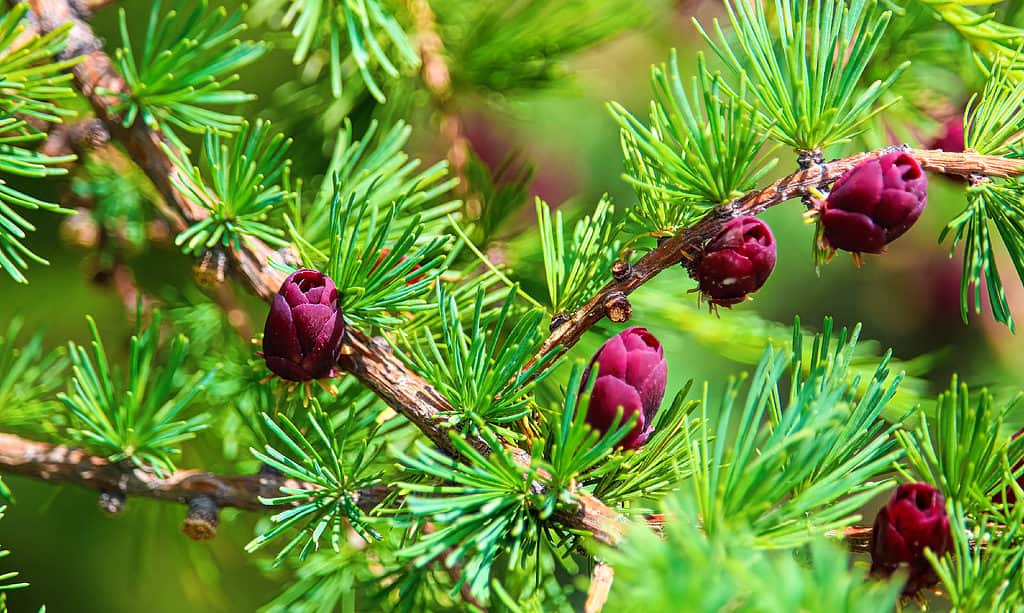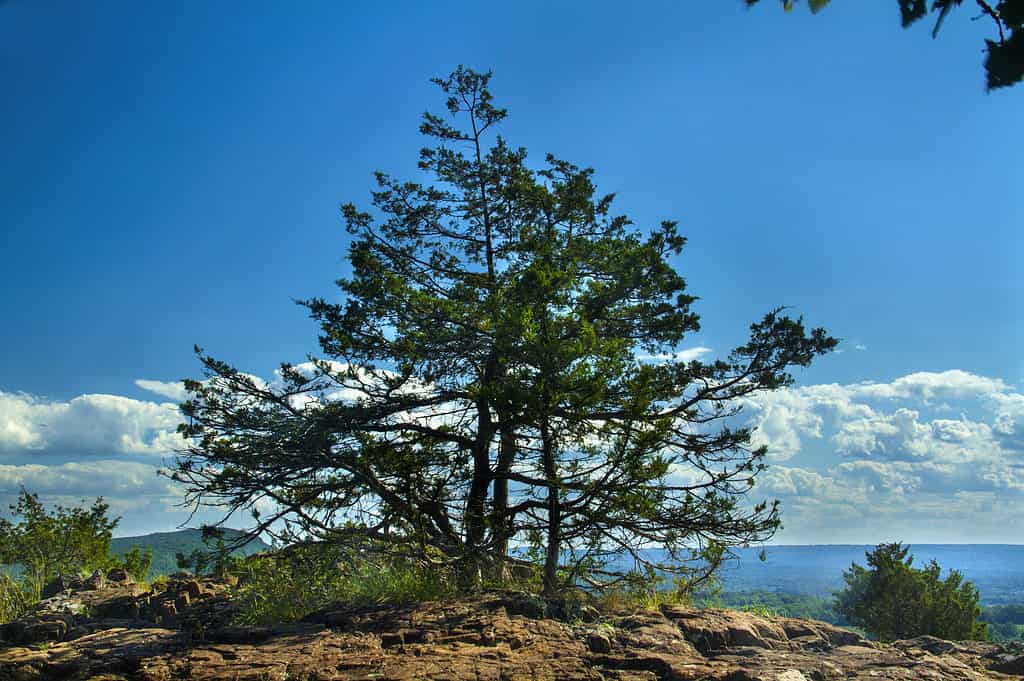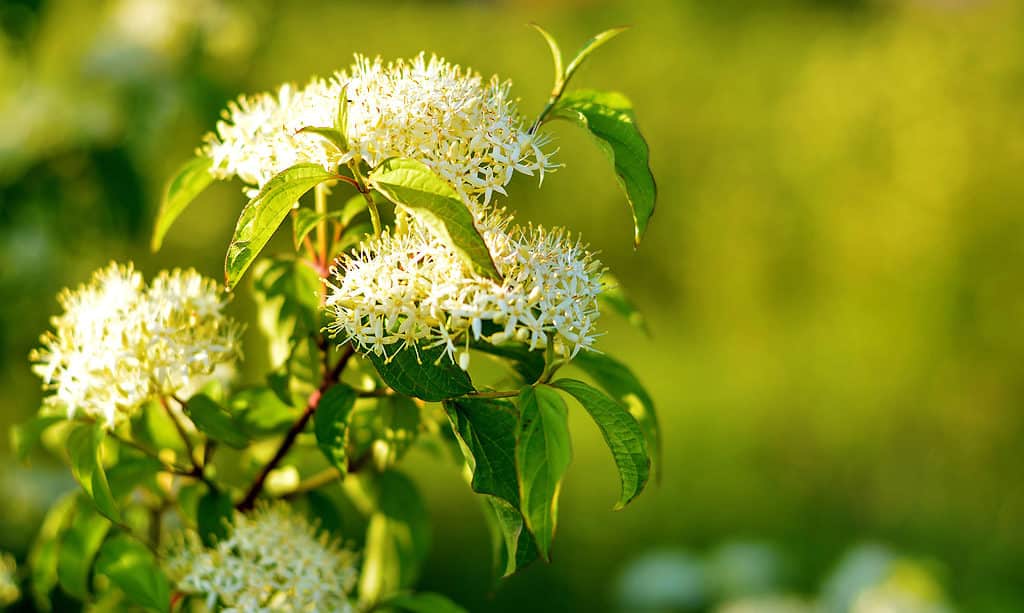The Empire State is certainly worth a visit! Besides having the possibility of exploring and enjoying the great New York City, you can see the state’s islands, lakes, valleys, and mountainous areas. Since it has such a diverse geography, New York is abundant in wildlife.
We’ve prepared a list of plants native to New York. If you visit the state during autumn, you have the chance to see one of the greatest autumnal foliages!
So, let’s cut to the chase and discuss some of the most beautiful plants native to the Empire State!
1. Northern Blue Flag

The northern blue flag reaches only around 31 inches in height.
©Edgar Lee Espe/Shutterstock.com
| Northern Blue Flag | |
|---|---|
| Scientific name | Iris versicolor |
| Other common names | Larger blue flag, harlequin blue flag, poison flag |
| Type of plant | Herbaceous perennial plant |
| Distribution | Eastern United States and Canada |
The northern blue flag is native to eastern North America, where it grows along stream banks and shores, in sedge meadows, and marshes. It’s not very tall, reaching only around 31 inches in height. The basal leaves grow on erect stems, folded in such a way that they form an overlapping flat fan.
The plant blooms from May to July, producing blue flowers with six petals and sepals, which spread out, revealing the flowers’ centers. Moreover, they can have two forms, and the longer petals feature a green-yellow blotch at the base.
Northern blue flag roots and leaves are poisonous, and Ingesting them can cause stomach aches and intestinal inflammation.
2. Common Milkweed

The common milkweed grows up to 5 feet tall, producing oppositely arranged leaves having an ovate-lanceolate shape.
©iStock.com/mr_coffee
| Common Milkweed | |
|---|---|
| Scientific name | Asclepias syriaca |
| Other common names | Butterfly flower, silky swallow-wort, Virginia silkweed |
| Type of plant | Perennial forb |
| Distribution | Central and eastern North America |
The common milkweed has major ecological importance, as it’s a food source for more than 450 insect species! Beetles, ants, wasps, butterflies, and bees delight in common milkweed plants! Moreover, it’s a primary food source for monarch butterfly caterpillars. Besides this, it’s a popular ornamental plant. However, it’s known to spread quickly, causing issues in small gardens.
This perennial grows up to 5 feet tall, producing oppositely arranged leaves having an ovate-lanceolate shape. The leaves have reddish veins and undulated margins. Common milkweed flowers are pinkish or purplish. They grow in umbellate cymes and attract numerous nectar-feeding insects.
3. Great Blue Lobelia

The flowers of the great blue lobelia are usually blue or violet but sometimes have lighter shades.
©iStock.com/skymoon13
| Great Blue Lobelia | |
|---|---|
| Scientific name | Lobelia siphilitica |
| Other common names | Great lobelia, blue cardinal flower |
| Type of plant | Herbaceous perennial |
| Distribution | Eastern and central United States and Canada |
The great blue lobelia lives only a few years but produces gorgeous flowers that bloom from August to October! They are usually blue or violet but sometimes have lighter shades. The flowers have five petals – the upper two are curled back, while the lower three are fused, which is why the plant has such a curious appearance!
The plant’s stem is unbranched and bears hairless or almost hairless leaves alternately arranged directly on the stem.
4. Virginia Rose

The Virginia rose blooms in midsummer, and the flowers last unusually long.
©iStock.com/Vincent Ryan
| Virginia Rose | |
|---|---|
| Scientific name | Rosa virginiana |
| Other common names | Prairie rose, common wild rose |
| Type of plant | Woody perennial |
| Distribution | Eastern North America |
The Virginia rose is probably one of North America’s most common wild rose species! It grows as a suckering shrub, meaning its shoots grow from adventitious buds at the plant’s base. It features stems covered in prickles, pinnate leaves with 7 – 9 glossy leaflets, and pink flowers that grow in clusters. The plant blooms in midsummer, and the flowers last unusually long.
The small, bright red fruits are a food source for some animals. People often add them to teas and jams since they are rich in vitamin C.
5. Black Gum

The black gum tree has a light reddish-brown bark and pale yellow wood that’s very durable and tough.
©Photo by David J. Stang / CC BY-SA 4.0, via Wikimedia Commons – License
| Black Gum | |
|---|---|
| Scientific name | Nyssa sylvatica |
| Other common names | Tupelo, sour gum, black tupelo |
| Type of plant | Deciduous tree |
| Distribution | Eastern North America |
Interestingly, although the tree is called black gum, it has no gummy parts. The unique thing about it is the autumnal leaf color!
The black gum tree has a light reddish-brown bark and pale yellow wood that’s very durable and tough. The leaves are alternately arranged on the branches and have an oblong to oval shape. When they reach maturity, the leaves are dark green and very shiny on top, while the undersides are pale and hairy. When fall sets in, the leaves become purple at first, then get an intense bright scarlet color. So if you’re planning to visit New York, you should definitely do this in autumn, as you’ll see the most beautiful autumnal tree foliage!
However, if you can’t visit in autumn, you can plan your trip for May or June, when the tree blooms and produces yellowish-green flowers with five petals. The fruits are fleshy drupes that ripen in October.
6. Tamarack

Tamarack cones are bright red at first but become brown when they mature.
©Amelia Martin/Shutterstock.com
| Tamarack | |
|---|---|
| Scientific name | Larix laricina |
| Other common names | Eastern larch, red larch, hackmatack |
| Type of plant | Coniferous, deciduous tree |
| Distribution | Canada, northeastern United States |
The tamarack is a boreal coniferous tree growing up to 66 feet tall. Its bark is pinkish-reddish, while the leaves are light blue-green and have a needle-like shape. The leaves grow on long shoots in dense clusters, and they turn a beautiful bright yellow color in autumn.
Tamarack cones are bright red at first but become brown when they mature. The trees are one of the hardiest, surviving severe temperatures of up to -85 degrees Fahrenheit. Besides this, they are highly adaptable and can grow well in various soils.
In cold regions, the tamarack tree makes an excellent ornamental tree. Even some dwarf cultivars have been developed so people can plant them in smaller gardens.
7. Eastern Red Cedar

The eastern red cedar has a reddish-brown bark and green leaves.
©iStock.com/Holcy
| Eastern Red Cedar | |
|---|---|
| Scientific name | Juniperus virginiana |
| Other common names | Red juniper, Virginian juniper, red cedar |
| Type of plant | Coniferous evergreen |
| Distribution | Eastern North America |
This coniferous evergreen tree grows slowly. Even more, it may never become a tree if it doesn’t grow in suitable conditions. A study shows that some eastern red cedars can add only around 6.5 feet to their height over eight years. Other specimens needed 10 – 14 years to reach 6 feet tall! Some trees were 20 – 27 feet tall when they were 28 years old, suggesting they added only 1.6 – 2 feet per year. On the other hand, it has a long lifespan, the oldest tree being 940 years old!
The eastern red cedar has a reddish-brown bark and green leaves. When they first appear, the leaves have a needle-like shape. When fully mature, they become scale-like and are oppositely arranged in whorls of three or pairs. The seed cones have a berry-like shape and are of a deep purple-blue color.
There are two eastern red cedar varieties: Juniperus virginiana var. virginiana and Juniperus virginiana var. silicicola. However, only the former species grow in New York.
8. Alternate-Leaved Dogwood

The alternate-leaved dogwood grows up to 25 feet tall.
©iStock.com/izzzy71
| Alternate-Leaved Dogwood | |
|---|---|
| Scientific name | Cornus alternifolia |
| Other common names | Green osier, pagoda dogwood |
| Type of plant | Deciduous shrub |
| Distribution | Eastern North America |
The alternate-leaved dogwood grows up to 25 feet tall. It can be easily distinguished in the wild by its branches. If you look closely, you’ll notice horizontal layers on the branches that are separated by gaps. The leaves are alternately arranged on the stems and have an elliptic to ovate shape. They have smooth, green upper sides and hairy, bluish undersides.
The tree bark is gray to brown. If the tree is old, you’ll notice ridges on its bark.
Alternate-leaved dogwood trees bloom in April and May, producing creamy flowers that grow in broad, open cymes. The flowers have four petals. The fruits appear in October, and they’re blue-black drupes.
Up Next:
- The 8 Most Beautiful Mountain Lakes in New York
- First Snow in New York: The Earliest & Latest First Snows on Record
- The 5 Best Spots for Leaf Peeping in New York: Peak Dates, Top Driving Routes, and More
The photo featured at the top of this post is © iStock.com/Lyudmila Chetvertnykh
Thank you for reading! Have some feedback for us? Contact the AZ Animals editorial team.






